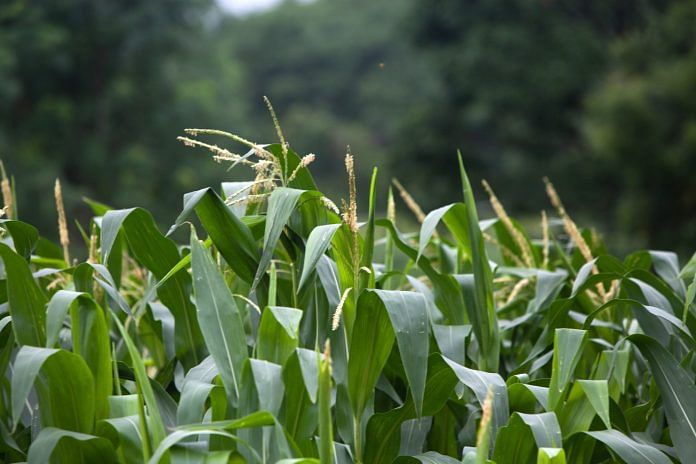Prices of crops such as cereals, oilseeds & pulses are hovering below govt-set levels in grain markets across the country.
New Delhi: India’s price support system for a range of crops is failing its most crucial test: shielding farmers from distress sales.
That’s brewing discontent in the nation’s hinterland and is capable of tripping Prime Minister Narendra Modi’s re-election bid.
Prices of crops such as cereals, oilseeds and pulses are hovering below the government-set levels in various grain markets across the country. Pearl millet is trading about 24 percent below the government’s support price, while corn, one of the major monsoon-sown crops, is quoted about 7 percent lower, according to prices quoted by some farmers.
While bumper harvests after a third year of satisfactory rainfall are to blame for the depressed prices, that’s been compounded by the absence of the state’s backing to ensure guaranteed rates, as announced, for as many as 22 crops.
In July, Modi’s government assured farmers of returns that are at least 50 percent more than the estimated production cost. While the government purchases about a third of the country’s wheat output and about 40 percent of the rice crop for its food welfare programs, it buys only small quantities of commodities like mustard and pulses.
Gathering Dust
At a government-run procurement center for corn in Shikohabad district of Uttar Pradesh — India’s most populous state that’s key to next year’s election outcome — the crop-weighing machine gathers dust, while farmers sell their produce to middlemen in the same market at discounted rates.
Fast Facts on Government’s Crop Purchase Procedure:
State deputes its official to a wholesale market Official weighs produce brought by farmers Crop is tested for quality and certificate issued to farmer Sale happens on basis of that certificate Payment is credited to farmer’s bank account within a few days
Nawab Singh, a 70-year-old farmer, who also works as a commission agent, approaches the guard manning the scales with two tons of corn but is turned away without a convincing reason. “I have been trying to sell it but they deny giving lame excuses,” he said Dec. 3 when Bloomberg reporters visited the center.
Singh sold his crop to the government-run outlet 10 days later and only after he told the officials that he will air his grievances to the media.
State governments, through which the program is implemented, aren’t able to buy enough of the crops due to inefficient procurement systems and, in part, a lack of infrastructure such as storage facilities.
“The failures are there because the government has not been able to strengthen the process of procurement,” said Laveesh Bhandari, head and chief economist for Indicus Foundation that works on social and economic inclusion. “It is a very extensive and difficult exercise.”
This is the third straight year that local supplies have been boosted by higher food grain, oilseed and sugar cane production. The resultant drop in crop prices has prompted protests by farmers in recent months.
Bureaucratic Hurdles
The lower prices aren’t the only concern for farmers. The distance of government purchase centers from their villages, strict and cumbersome quality standards and bureaucratic hurdles have also prompted selling to private buyers.
Farm Secretary Sanjay Agarwal didn’t respond to two call on his mobile phone.
The distress faced by farmers, a key support base for political parties, is the latest challenge for Modi, who promised to double farm incomes by 2022. His Bharatiya Janata Party was jolted by defeats in key regional elections last week and as he prepares to face voters in a national election early next year, such unfulfilled promises could prove to be his undoing.
Failure to make good on the guaranteed price program will mean the government will save on cash outgo. It had initially estimated an additional 150 billion rupees ($2.12 billion) spending to purchase crops. Modi aims to contain the fiscal deficit at 3.3 percent of gross domestic product in the year to March and retain investors’ confidence in the economy.
Poor Showing
The absence of government support has also kept food prices low, a key reason why India’s inflation has slowed sharply below the 4 percent midpoint of the central bank’s inflation target. The resultant dip in farm incomes may damp rural demand in an economy where activity is already showing signs of cooling.
“It’s a wake up call for them,” Raghbendra Jha, an economics professor at the Australian National University, said, referring to Modi’s BJP. “The government is caught in a jam as it finances are under stress.” – Bloomberg




http://www.economicsdiscussion.net/agriculture/productivity-level-of-indian-agriculture-factors-and-measures/2093
Productivity Level of Indian Agriculture: Factors and Measures
India has no choice to produce more food to become self sufficient in food production to feed its growing population and balance to export to earn valuable foreign exchange and make rupee strong